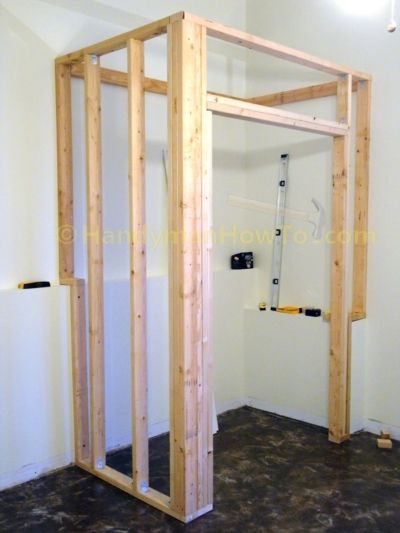Framing 2x4 Wall

Framing 2x4 wall
In general, 2 x 4 wall framing is structurally sufficient for many small garages and sheds. When bearing wall heights do not exceed 10 ft. 2 x 4 framing is generally code compliant.
How much space should be between 2x4 studs?
You may wonder: How far apart are the studs in my home? They're always spaced either 16 or 24 inches on center (measured from center to center) along the wall and run between the floor and ceiling. Drywall or lath (for plaster walls) attaches to the edge of the studs.
Do studs have to be 16 on Center?
Rather than measuring the distance between the edges of the studs, you measure the distance from the center of one stud to the other center of another stud. How far apart are studs in a wall? Studs should be placed 16 inches apart on center. There are certain exceptions to this rule but this is the standard.
How thick is a 2x4 stud wall?
Typical interior walls are framed with 2x4s. This makes walls about 4½ inches thick (3½ inches of wood covered on both sides by ½-inch-thick drywall).
Should wall studs be 16 or 24?
To summarize, studs at 24-inch spacing will save money and resources, and are safe. With 2x6s, it's a no-brainer for most residential construction—they're plenty strong in nearly any configuration. With 2x4 studs you can also get by with 24-inch spacing, but walls should be 9 feet tall or less and the loads modest.
Can a 2x4 wall be load bearing?
If it's a solid 2x6 or greater turned vertically going from the jack stud on one side to the other, there's a good chance the wall is load bearing. If there are only cripple studs on a flat 2x4 to give you something to attach the drywall, it likely isn't load bearing.
Should interior walls be 2x4 or 2x6?
2×6 construction creates more room for wall insulation, which can help enhance home efficiency and reduce cooling and heating bills throughout the warmest and coldest months of the year.
How do you lay a 2x4 stud wall?
Ok first start with your top. And your bottom plate lay. It down on a table or the floor line them
How far is the first stud from a corner?
A good starting place is 16 inches from a corner. For better precision, use a tape measure and mark 12 inches, 16 inches, and 24 inches from the corner.
Can I use my iPhone as a stud finder?
However, the iPhone's built-in magnetometer does allow apps to locate metal wall studs, nails, screws or any ferromagnetic material—meaning it also won't work on some types of stainless steel. ENR compared 16 stud-finding and metal-detection iOS apps.
Why are my studs 18 inches apart?
In some new homes, studs may be spaced 24 inches on center; in houses built before World War II, they are often erratically spaced on centers of 12 to 18 inches or more, especially if the walls are plastered. Prewar studs ordinarily are a full 2 inches thick and 4 wide.
Why do you need a double top plate?
The top plate serves an important role in providing wood fiber for the perimeter nailing of structural and/or insulated sheathing. A second top plate, also known as a “double plate” or “very top plate” is applied in the field to lock together intersecting walls.
Can I put r19 in a 2x4 wall?
| Best Insulation for 2x4 and 2x6 Wall Studs | ||
|---|---|---|
| R-19 | 6 1/4 Inches (+/-) | Two-by-six (2x6) stud walls |
Do wall studs run vertical or horizontal?
Studs are positioned perpendicular to the wall they're forming to give strength and create space for wires, pipes and insulation. Studs are sandwiched between two horizontal boards called top and bottom plates. These boards are nailed or screwed to the top and bottom ends of the studs, forming the complete wall frame.
How far apart should studs be in a wall?
The general spacing for wall studs is 16 inches on center, but they can be 24 inches.
Can you hang drywall on 24 centers walls?
drywall thickness, lightweight is ideal for ceilings that have joists 24 inches on center. Regular 1/2-in. drywall has always been approved for use on 24-in. spacing on ceiling framing, but because of heavy sagging insulation, wet ceiling textures, or higher humidity, either a 1/2-in.
Can you frame 24 on Center?
Structurally, in most cases, exterior wall framing can easily be 24 in. o.c. as well. (The exception, according to the 2015 IRC, is 2×6 walls supporting two full floors plus a roof assembly above, or 2×4 walls supporting one floor plus a roof assembly above.)
Why are wall studs 16 inches apart?
This is the main reason that drywall is 4-ft wide and why studs are spaced at 16-inches. Because drywall is four feet it is divisible by 16. This means that each piece of drywall will be centered at each stud. This means you won't have to cut each piece of drywall if the walls are 8-ft tall, which is also the standard.
How much weight will a 2X4 wall support?
As we discussed above, 2x4s are much stronger vertically than they are horizontally. A 2×4 can support up to 1,000 pounds vertically. This dimensional lumber is the most common material used to frame interior and exterior walls on a home.
Is a 2X4 stronger than a 2x6?
The total bearing area of three 2x4s is 15 3/4 square inches; two 2x6s have a bearing area of 16 square inches. In bending, however, such as from a wind load, a 2x6 wall is considerably stronger. In tall walls, where column buckling might be a factor, a 2x6 wall would be stronger if a structural sheathing was used.








Post a Comment for "Framing 2x4 Wall"